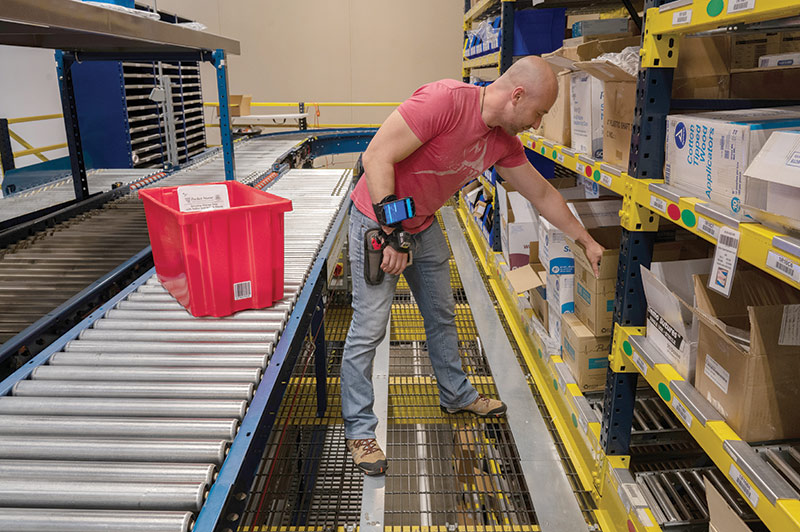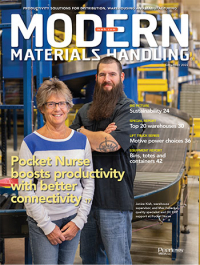Pocket Nurse boosts productivity with better connectivity
A provider of educational, simulation and training materials to the healthcare industry, Pocket Nurse is using wearable devices and a mobile computing platform to eliminate dropped signals, increase productivity and improve associate morale.
John Hill, an industry thought leader, used to say that if 6,000 warehouses are in the United States, only 600 of them are automated. His point was that the automation technologies we see on the floor at ProMat, where Hill was a long-time presenter, represented the promise of the industry while most warehouse operators were still getting the job done with conventional technologies, like bar code scanning, conveyor and sortation.
There are probably far more than 6,000 warehouses in the United States today, but Hill’s point, and probably his math, is still valid. We’re in the midst of an automation revolution, with more automated storage, autonomous mobile robots (AMR) and technology-enabled, goods-to-person picking than ever. At the same time, the go-to design for most distribution centers remains picking to a cart or picking to a bin in a multi-level pick module, with conveyor and sortation as the most common automation. In those facilities, mobile data collection and bar code scanning empower operations.
Take a look inside at the layout of the new Pocket Nurse facility.
That describes the 100,000-square-foot facility that Pocket Nurse built in Monaca, Pa., near Pittsburgh. The company serves an important niche of the healthcare industry, providing the simulation and educational products used to train nurses, EMTs and other healthcare professionals, such as those who administer CPR.
The facility uses conveyor, sortation, and automated weighing and cubing to augment its processes. But, the heart of the operation is a multi-level pick module where associates are system directed to pick items into bins that are then routed through the pick module before they are conveyed to packing. The company processes 300 to 500 orders a day, using zone selection picking; most are multi-line orders ranging from one bin to dozens of bins.
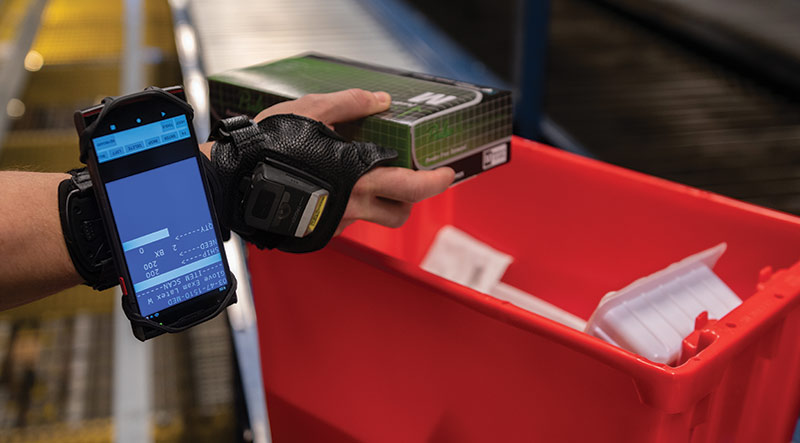
The challenge, according to Janice Kish, warehouse supervisor, and Max Fallecker, quality specialist and DC ERP support, was that the mobile computing and data collection technologies in place, including the handheld bar code scanners that directed associates on the floor, were 10-year-old Windows CE devices and behind the times from a technology standpoint.
The handheld devices slowed down picking; more importantly, associates were experiencing a large number of dropped signals on the floor. Often, if they were in the middle of a task, they would not only have to wait for the system to reboot, but they’d have to start the task over again.
“The original IT implementation team had moved on, so there was knowledge loss, and we, including the current IT team, had a difficult time finding manufacturer support or any online resources to help us troubleshoot issues,” notes Fallecker.
Adds Kish: “Anyone in warehousing knows that once you take an associate out of their picking flow, it’s hard to get them back into it. If you’re waiting 20 minutes to get the system fixed, you’re going to lose your momentum, not to mention morale.”
The solution was a complete overhaul of the company’s mobile computing and data collection technologies, including a new Wi-Fi network. The solution included wearable warehouse technology and a workforce analytics software platform that modernized the Windows CE handheld scanners that had been in place (Rufus Labs). The hardware and software platform was enhanced by a new terminal emulation platform that delivered a user-friendly graphical interface and improved Wi-Fi connectivity (StayLinked).
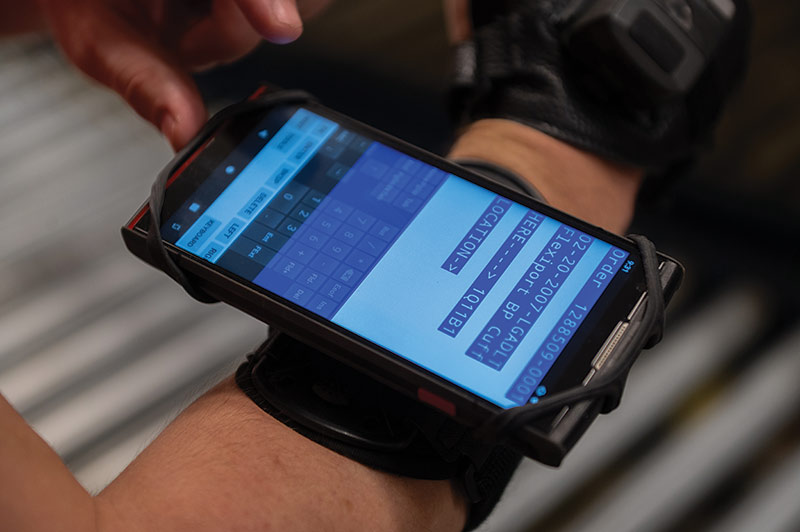
The result, according to Kish and Fallecker, is that dropped signals have been nearly eliminated, improving employee morale; the new technology is also driving significant productivity improvements. “Prior to this, it could take 10 days to turn an order, and we’re now turning most orders in two to three days,” says Kish. “And, we are developing the capability to turn priority orders in a day.”
“There are still some service drops—you’ll never have 100% connectivity in a warehouse,” adds Fallecker. “But with our new platform, the connection is re-established in 15 seconds, not 15 minutes, and the associate can resume right where they left off.”
Serving educational needs
Like a number of specialized businesses and industries, Pocket Nurse was founded to serve an unmet need in the healthcare community identified by its founder, Anthony Battaglia, who was a nurse.
Battaglia launched the company in 1992 with one product, the Pocket Nurse, a pocket organizer that included tools that working nurses used most often: bandage scissors, a hemostat, an integrated penlight and an engraved nameplate. While that initial product was a success—and, is no longer offered by the company—Battaglia had a vision to help health educators in their instructional and training efforts.
“When Anthony founded the company, this was an underserved market,” recalls Kish. “He recognized a need for teaching implements, started with simple items and grew the business from there.”

In the 30 years since, the company has both sourced and, when necessary, created and manufactured products that deliver on that goal. One example is the company’s InjectEd injection simulator, a product line that helps students learn how to safely and effectively use needles to inject medication. Today, the company manages or has access to 10,731 SKUs, including nearly 5,000 selected on a regular basis.
“We strive to be a one-stop shop for everything needed in this space, and even things they don’t know they need,” says Fallecker, adding that Pocket Nurse recently sourced and shipped a simulation K9 leg for veterinary training. “We keep a huge in-stock offering, and a special order and drop ship offering that is just as big,” he says. In addition to new offerings, Pocket Nurse is expanding into new markets, including a growing international business.
Distribution capabilities have grown with the expansion of the product line and business. Battaglia initially filled orders from a small space in the back of a doctor’s office, expanded into a garage and then into a 25,000-square-foot facility before building the 100,000-square-foot, semi-automated DC now in use. Located outside of Pittsburgh, the building features a large reserve storage area, a multi-level pick module and manual packing tied together by a conveyor and sortation system.
Like many small distributors, Pocket Nurse’s business is evolving in ways that impact its order fulfillment operations. While the company’s workforce is stable, with some employees who have been in the warehouse as long as there has been warehouse operations, customer expectations are changing, especially with regard to delivery times.
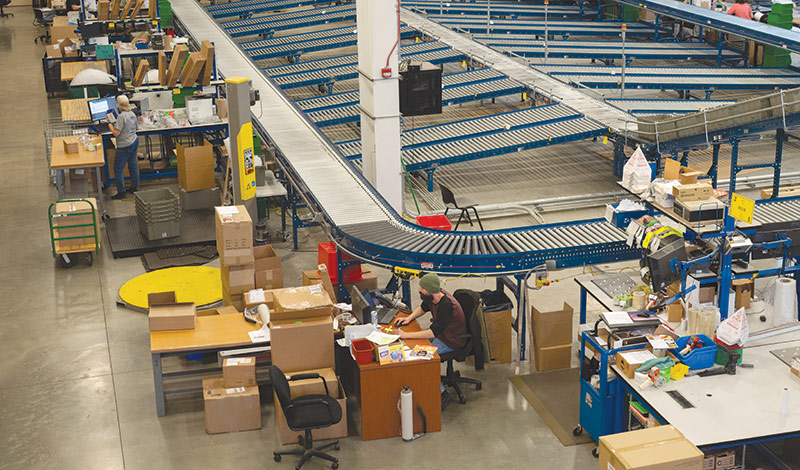
“Our customers want us to be like Amazon,” says Kish, who notes that prior to Covid, a 10-day turnaround for orders was the norm. “During Covid, we were an essential business and continued to ship while most people were working from home. We were trying to turn orders faster than ever.”
The goal was to get to one- to three-day order turnarounds. To do that, they realized they had to make process changes. One impediment was the existing RF network and bar code scanning technology. “Meeting customer requirements is the primary reason why we did this project,” Kish says.
Making connections
Prior to this project, Pocket Nurse was working with 10-year-old handheld bar code scanners and an aging Wi-Fi network. By the summer of 2020, as the company was also attempting to speed up order turn times, signal drops in the warehouse from the aging equipment were having a significant impact on productivity.
Kish and Fallecker say it wasn’t uncommon to have five drops a day and that it could take up to 20 minutes for an associate to get back up to speed. “Once the pickers lost signal, they couldn’t get back to where they left off in the process,” Kish says. “They would have to start all over. A lot of times, they couldn’t even sign in.” Part of getting back to square one involved manipulating database server records.
In November 2020, Kish and Fallecker began looking at potential vendors for the project. They selected their equipment vendor based on the Android operating system, the fact that wearable scanning devices were so much easier for operators than traditional handheld devices and, perhaps most important, was the workforce analytics and productivity dashboard that delivered insights into how associates were performing against key performance indicators.
Despite upgraded equipment, issues with connectivity were not resolved, and the migration to the new equipment was put on temporary hold until Pocket Nurse could upgrade its Wi-Fi network. In the fall of 2021, Rufus brought in StayLinked, a provider of supply chain terminal emulation technology.
The terminal emulation platform transforms traditional green screen application screens into easy-to-use graphical screens with no changes to the underlying enterprise application.
The combination also delivered near continuous connectivity to the facility Wi-Fi network. “We have a big warehouse and there are Wi-Fi dead spots, so we may still drop connectivity on occasion,” says Fallecker. “The difference is that the connectivity drop is now moments instead of minutes.” And, when an associate is reconnected, they can pick back up at their last transaction. “There are no more stuck sessions or situations where I have to go into the database and manipulate records.”
“We no longer have starts and stops,” Kish notes. “I can look into the dashboard and see how many scans, how many steps and so on.”
The transition to the new equipment and platform, along with an upgraded Wi-Fi system, was complete in the spring of 2022. Kish says the changeover was seamless, requiring no changes to existing processes and no down time to operations. Kish adds that employees are now scanning 12% faster than with their previous devices, and the facility is consistently turning orders in two to three days.
“We think if we stay the course, we can get critical orders down to one day by the end of the year,” says Kish. “We’re not going to stay stagnant.”
Fallecker notes that employee morale is also significantly improved. “We have 99% employee satisfaction with the new bar code scanning technology,” he says. “They can now do what they need to do and keep moving. That’s a big change.”

Article Topics
Conveyors News & Resources
2024 Intralogistics Robotics Survey: Robot demand surges Problem Solved: How a Fulfillment Center Got Back on Track Coesia acquires AMC, LLC Power Transmission: From horseback to rocket ship Regal Rexnord to sell its Industrial Motors & Generators businesses to WEG Van Meter: Saving space while increasing throughput Van Meter optimizes with vertical lift modules (VLMs) More ConveyorsLatest in Materials Handling
Registration open for Pack Expo International 2024 Walmart chooses Swisslog AS/RS and software for third milk processing facility NetLogistik partners with Vuzix subsidiary Moviynt to offer mobility solutions for warehouses Materials Handling Robotics: The new world of heterogeneous robotic integration BSLBATT is looking for new distributors and resellers worldwide Lucas Watson appointed CSO for Körber’s Parcel Logistics business in North America Hyster recognizes Dealers of Distinction for 2023 More Materials HandlingAbout the Author
Subscribe to Materials Handling Magazine

Find out what the world's most innovative companies are doing to improve productivity in their plants and distribution centers.
Start your FREE subscription today.
April 2024 Modern Materials Handling

Latest Resources


